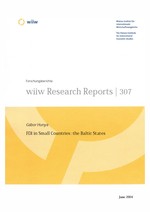FDI in Small Countries: the Baltic States
wiiw Research Report No. 307, June 2004
23 pages including 3 Table and 8 Figures
Analysing the evolution and determinants of foreign direct investment (FDI) in Estonia, Latvia and Lithuania, this paper argues that sound economic policies have created an environment conducive for FDI. Overall, FDI has contributed to economic growth in the Baltic economies, having financed around one-fifth of fixed investment. However, their small size makes the Baltic countries relatively less attractive for market-seeking FDI in manufacturing. Moreover, at the outset of transition, their economies were dominated by relatively uncompetitive low-technology industries, which made them less interesting for manufacturing-based export-oriented FDI. Thus, FDI largely went to relatively low-technology sectors, such as wood processing and food, and it has not helped radically transform the structure of the manufacturing sector. A major part of FDI went into services, including banking and telecommunications, contributing to increasing efficiency in the whole economy.
JEL classification: F21, P33, O24, O52
Countries covered: Estonia, Latvia, Lithuania, Baltic States
Research Areas: International Trade, Competitiveness and FDI
